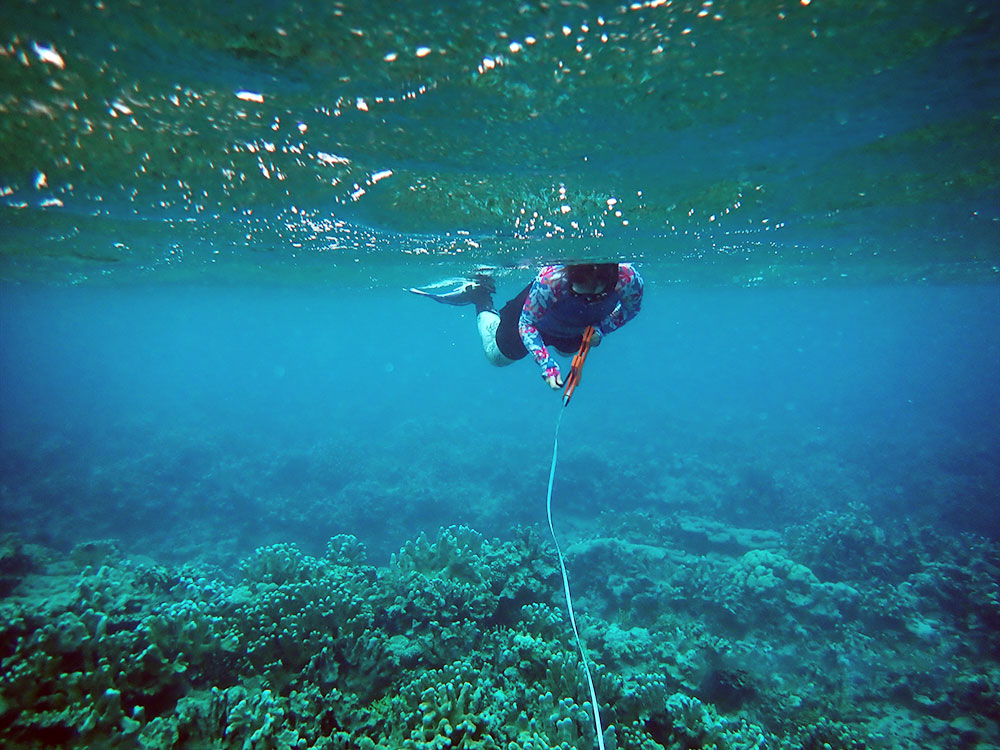
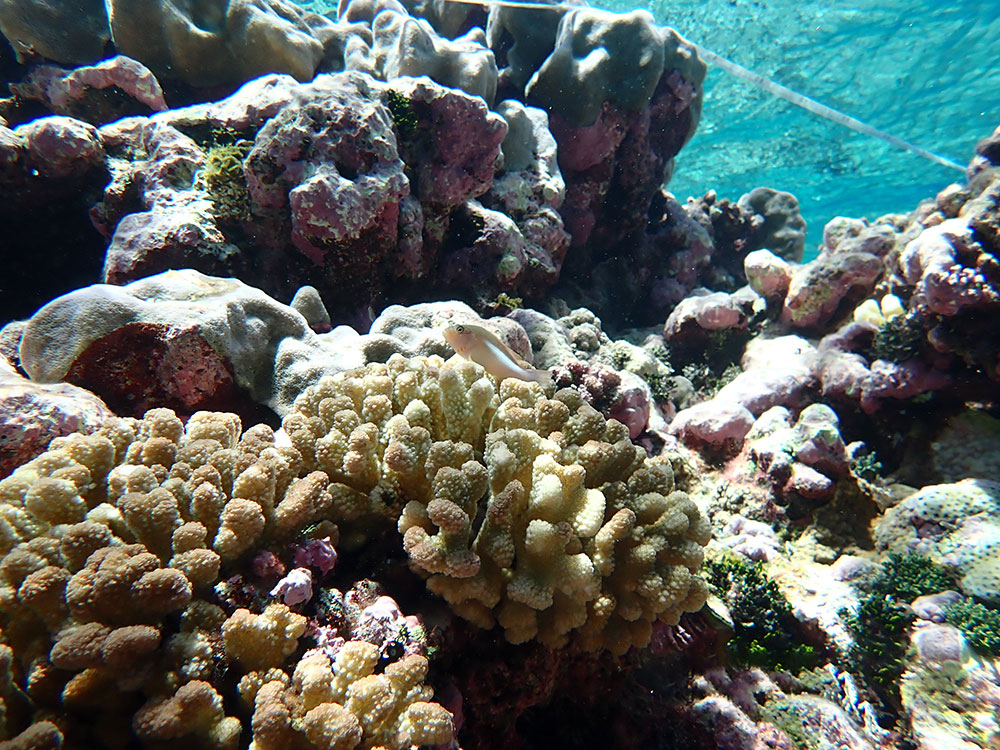
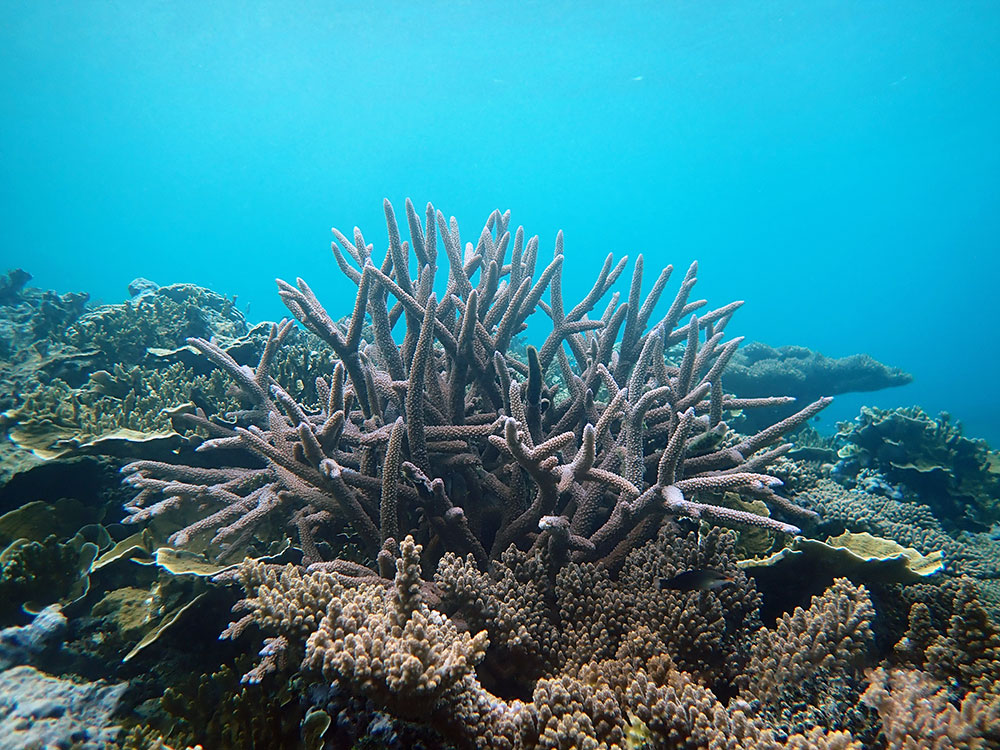
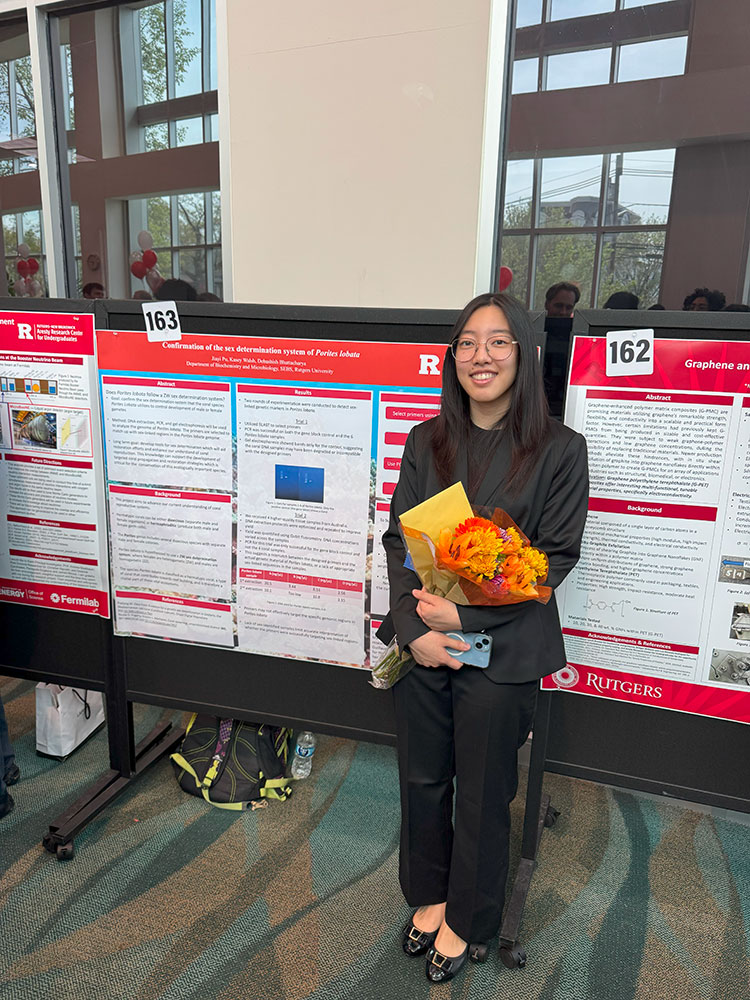
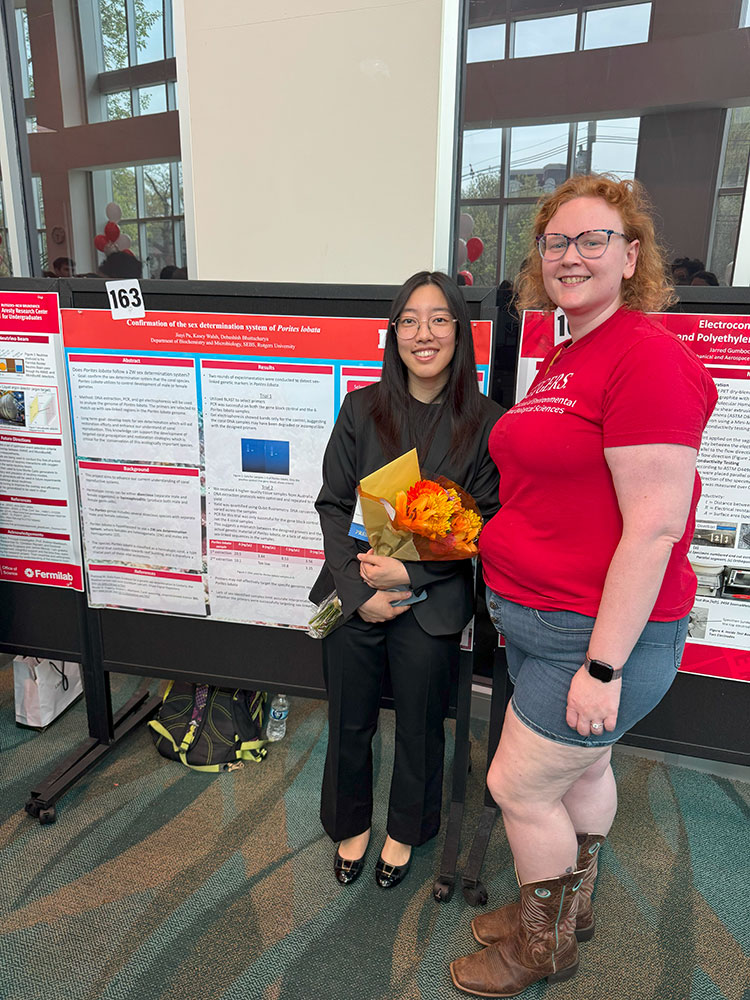
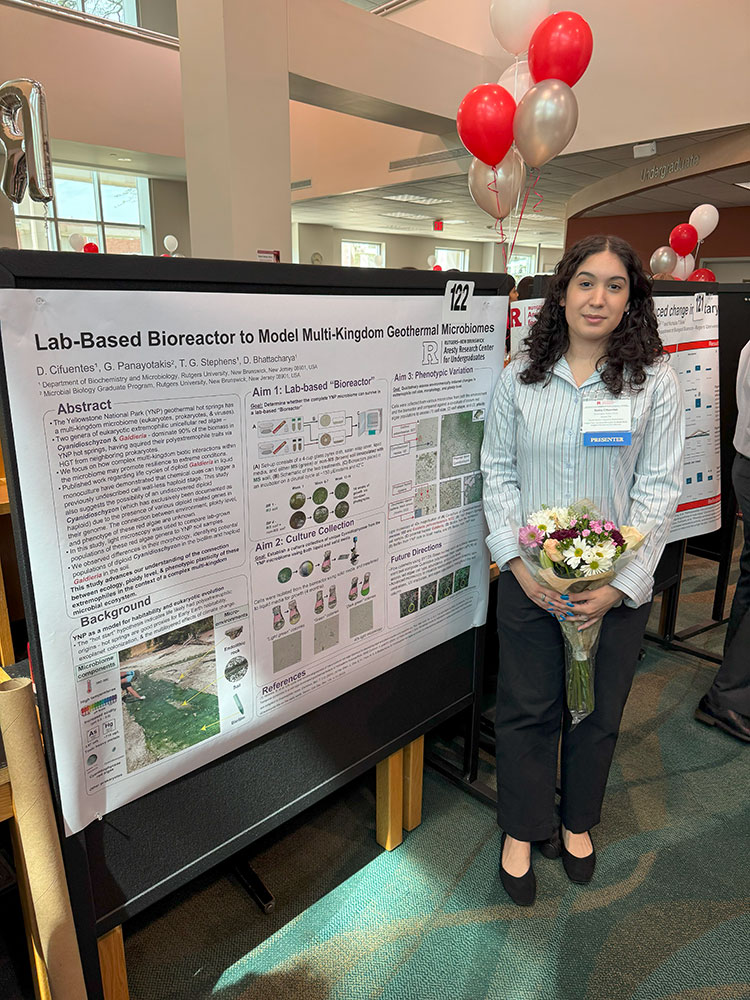
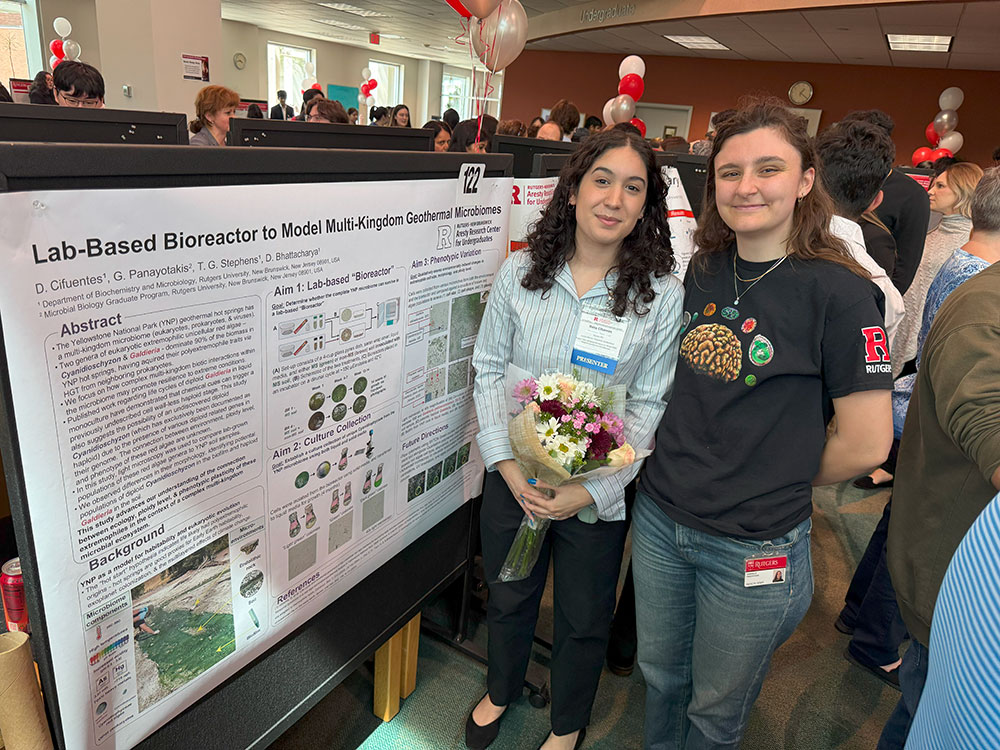
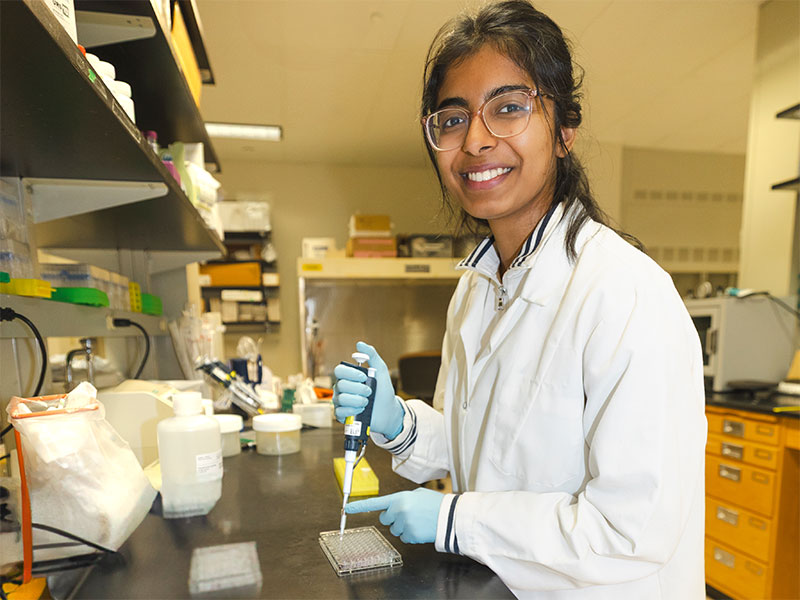
Shriya is a senior in the SEBS Biotechnology program, general option. As a New Brunswick Honors College student, she started her undergraduate research on corals in the Bhattacharya Lab in her junior year through the Aresty Research Assistant program. She continued her work with paid summer internships, and by pursuing her G.H. Cook Honors Thesis.
Shriya’s research in the Coral Hospital initiative is to test and validate whether health test kits that are developed for humans can be used on marine species, using corals as the initial test case. Corals suffer from warming oceans that can result in “bleaching” (loss of algal symbionts) and are also prone to devastating diseases such as Stony Coral Tissue Loss Disease (SCTLD) that has eliminated coral reefs in Florida and spread throughout the Caribbean region.
The research Shriya presented to the program described the testing of specific chemicals in coral tissues that act as markers of reef health. She has adapted the popular Urinalysis test kit developed to diagnose human health to corals. This approach offers a rapid and inexpensive way to assess how corals are faring in the field. The coral results are being validated using quantitative metabolomics with collaborators at the core center of the Rutgers Cancer Institute.
Shriya’s mentor, Ecology and Evolution graduate program student Erin Chille, suggested to her to apply for the D.O.O.R.S. program. It is a nationwide Mentorship and Scholarship Program, which aims to recognize and empower 10 undergraduate students each year in life science who represent underrepresented groups. It is funded by Promega and the BioPharmaceutical Technology Center Institute (BTC Institute). The scholarship supported Shriya’s tuition and advanced her research skills via the Biotechnology major. The award also includes a Mentorship Program with a professional from the biotech industry, and participation in D.O.O.R.S. Scholar’s Day 2025, an in-person event held at the BTCI / Promega campus in Madison, WI.
On August 10, 2022 Arwa Gabr successfully defended her PhD thesis, entitled,
“LIGHT AND LIFE: EVOLUTION OF PHOTOSYNTHESIS AND LIGHT USAGE IN PHOTOSYNTHETIC PAULINELLA.”
ABSTRACT
The uptake and conversion of a free-living cyanobacterium into a plastid (site of photosynthesis in eukaryotes) is undoubtedly one of the most important innovations that changed the evolutionary trajectory of life on our planet. Transforming the biosphere, plastid primary endosymbiosis laid the foundation for terrestrial life and the evolution of multicellularity. Therefore, a massive effort has been expended to elucidate plastid origin, function, biogenesis, diversity and its impacts on global primary productivity and geochemical cycles. A more recent case of plastid origin (ca. ~124 million years ago) occurred in the thecate amoeba Paulinella that acquired a plastid (referred to as the chromatophore) from an alpha-cyanobacterial endosymbiont. Evidence suggests that although these protists contain a bona fide photosynthetic organelle, these compartments are a “work-in-progress” with regard to plastid integration, making the Paulinella lineage an ideal model for studying the evolution of primary endosymbiosis. In my doctoral research, I investigate the evolutionary adaptation to light and photosynthesis with a focus on host control of photosynthetic performance in photosynthetic Paulinella(specifically, P. micropora strain KR0I, also referred to as, KR01). My work shows that the amoeba host undergoes massive genetic reconfiguration, generating genetic novelty and evolving key traits in order to accommodate and control the photosynthetic organelle. As an example, one of the earliest host contributions to chromatophore evolution in KR01 was the rescue of chromatophore functions by the targeting of 291 nuclear-encoded proteins to the photosynthetic organelle via a novel chromatophore-targeting peptide (crTP). Evolution of this targeting system is not the only significant example of genetic innovation in photosynthetic Paulinella. In fact, analysis of genomic and transcriptomic data from KR01 suggests that this lineage independently evolved a mechanism for nuclear mRNA regulations termed spliced leader trans-splicing (SLTS). Playing a role in the integration of novel “dark” genes and genes of foreign origin acquired via EGT or HGT in KR01, SLTS can alter protein sequence and is hypothesized to generate genetic novelty that can be acted upon by natural selection to facilitate chromatophore integration. Genomic and transcriptomic analyses also revealed that loss of endosymbiont genes results in host “rescue” to facilitate organelle integration. This process was observed in nucleotide synthesis and DNA replication, whereby a handful of genes that encode key enzymes were lost from the endosymbiont genome, leaving only the host nuclear-encoded copies to rescue the functions. This process allowed the host to gain control over major functions of the endosymbiont through relatively small evolutionary steps. Growth and adaptation to light are also key to photosymbiont integration. Investigation of the slow growth and light sensitivity of KR01 using biophysics tools showed no obvious evidence of photosystem II (PSII) impairment. However, it seems that KR01, and other photosynthetic Paulinella species lack photoprotection mechanisms that are present in cyanobacteria. These results lead to the hypothesis that restriction to low light environments in KR01 might be a mechanism to mitigate the formation of reactive oxygen species (ROS) generated under peak solar intensities. The strong selective pressure to integrate the chromatophore into host metabolism has resulted in Paulinella evolving a suite of other novel traits, including a C4-like carbon assimilation pathway. Evolved de novo within this previously heterotrophic lineage, RNA-seq data show that the C4-like pathway in KR01 is upregulated in response to high light and downregulated under elevated CO2. With most of the C4-related genes being of eukaryotic origin, these results demonstrate yet another significant host-specific innovation in the Paulinella lineage that arose to ensure chromatophore function and enhance organelle integration. My work makes significant strides in elucidating how plastids are integrated into host cell biology and provides the tools and understanding to potentially modify algae and plants to enhance their growth and fitness.

Shrinivas Nandi
PhD Student,
Microbial Biology
sn809@scarletmail.rutgers.edu
Life is beautiful – with Ursula Goodenough Jul 24, 2023
Dr. Ursula Goodenough has a scientific career that spans six decades, numerous accolades, and is a writer of both textbook and popular science books. But her crowning achievement …
Choanoflagellates and animal evolution – with David Booth Apr 17, 2023
Choanoflagellates are unicellular protists but they also happen to be the closest living relatives to animals. This week, David Booth discusses what choanoflagellates are, where …
Getting to know lichens – with Dennis Waters Apr 10, 2023
Do you ever walk past an old building or a tree or a big rock and notice splotchy green or orange or yellow blobs growing all over it? Well, these are probably lichens! Lichens are …
Fungi are everywhere – with Kaydubs the hiking scientist Mar 20, 2023
Is fungi everywhere? Is it on our eyeballs and in our nose hairs? Yes, yes, and yes! This week I talk to Dr. Kristen aka Kaydubs about fungi in general and forest fungi in particul …
Tardigrade takedown – with Chloé Savard Mar 13, 2023
Tardigrades aka water bears aka moss piglets are extremely popular! This is due to their tolerance of harsh environments and because of their perceived “cuteness”. This week, I speak with Chloé Savard (@tardibabe) about what tardigrades are, what it actually means to “survive” in extreme conditions, and how to find them in nature…
The gut microbiome – with Haley Hallowell February 27, 2023
What are the microbes in our gut up to? And how does their life affect our lives? This week, Dr. Haley Hallowell teaches us all about the gut microbiome and virome, that is, how …
Polar microbes – with Jaz Millar February 20, 2023
Did you know there are microbes living in holes in glaciers? What are they doing there and what can we learn from them? Quite a lot actually! This week, Dr. Jaz Millar and I talk a…
The Great Oxygenation Event – With John Encarnacion February 13, 2023
How do we know what the Earth was like billions of years ago? And where did all the oxygen come from? Spoiler alert: it’s microbes! This week I speak with Dr. John Encarnacion about…
Hobby microscopy – with Lena Struwe February 6, 2023
How can you get started with hobby microscopy? What products and practices do we recommend? Why do we have a conflict with the Unicode emoji consortium? And what on earth is a vine…
Hot springs archaea – with Arthur Charles-Orszag Jan 30, 2023
Why don’t we ever talk about archaea? What can we learn from this domain of life? Why would someone want to cook a chicken in a Yellowstone National Park geyser? Find out about the…
Genetic engineering of algae – with Kyle Lauersen Jan 16, 2023
What can we get algae to do for us (other than be beautiful and produce half of our oxygen)? How can we engineer different algae to create products and services we need? And what …
Cyanophora paradoxa – with Debashish Bhattacharya Jan 09, 2023
What the heck are glaucophyte algae? And where are they found? Spoiler alert: everywhere and nowhere. This week, Prof. Debashish Bhattacharya talks about Glaucophyta, one of the most …
Photosynthetic Paulinella – with Arwa Gabr Jan 02, 2023
“Photosynthesis is very important if you care about breathing.” Half of the oxygen on the planet is produced by microbes. Dr. Awra Gabr talks about the photosynthetic Paulinella …
Cassava mosaic begomoviruses – with Alvin Crespo Dec 26, 2022
As a society we have (rightly) spent soooo much time talking and thinking about SARS-CoV-2 but what about the billions of other viruses out there, most of which don’t infect humans …
The microbes transforming our food system – with David Zilber Dec 19, 2022
Did you know that one third of the food we eat is transformed by microbes? Why did people start eating sauerkraut? Will veggie burgers ever taste better? Is humanity doomed??? We a …
Physarum polycephalum – with Kyle DavidDec 12, 2022
What do some amoebozoans and the urban planners of Tokyo have in common? And who is smarter? What even is intelligence? Find out by learning about Physarum polycephalum, a slime mo …
Leptospira spp. – with Kyra Hartog Dec 05, 2022
If you have a dog, you’ll want to listen to this one! Leptospira is a genus of spirochete bacteria that can infect many different mammals, from rats to rhinos. Veterinarian Kyra Ha …
Naegleria fowleri – with Seth Bromagen Nov 28, 2022
Naegleria fowleri is a Percolozoan flagellate protist known as the “brain-eating amoeba”. While fatal to humans, this microbe doesn’t have a sinister motive. In fact, as Dr. Bromag …
Tiny Living Beings: Trailer Nov 26, 2022
“The world shimmers, a pointillist landscape made of tiny living beings.” -Lynn Margulis Tiny Living Beings is a weekly podcast where listeners get to know a scientist, a weird mic …